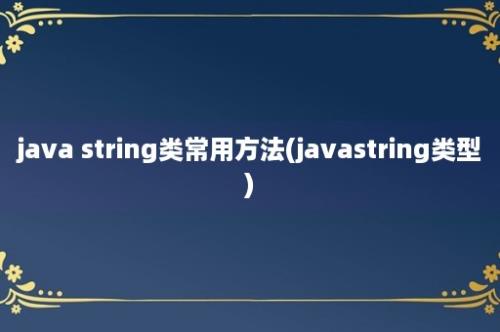javastig类常用方法(javastig类型)
导语:java常用类---String类

String类的概述和使用(掌握)
(1)多个字符组成的一串数据。
其实它可以和字符数组进行相互转换。
(2)构造方法:
A:public String()
B:public String(byte[] bytes)
C:public String(byte[] bytes,int offset,int length)
D:public String(char[] value)
E:public String(char[] value,int offset,int count)
F:public String(String original)
下面的这一个虽然不是构造方法,但是结果也是一个字符串对象
G:String s = &34;;
(3)字符串的特点
A:字符串一旦被赋值,就不能改变。
注意:这里指的是字符串的内容不能改变,而不是引用不能改变。
B:字面值作为字符串对象和通过构造方法创建对象的不同
String s = new String(&34;);和String s = &34;的区别?
(4)字符串的面试题(看程序写结果)
A:==和equals()
String s1 = new String(&34;);
String s2 = new String(&34;);
System.out.println(s1 == s2);// false
System.out.println(s1.equals(s2));// true
String s3 = new String(&34;);
String s4 = &34;;
System.out.println(s3 == s4);// false
System.out.println(s3.equals(s4));// true
String s5 = &34;;
String s6 = &34;;
System.out.println(s5 == s6);// true
System.out.println(s5.equals(s6));// true
B:字符串的拼接
String s1 = &34;;
String s2 = &34;;
String s3 = &34;;
System.out.println(s3 == s1 + s2);// false
System.out.println(s3.equals((s1 + s2)));// true
System.out.println(s3 == &34; + &34;);// false 这个我们错了,应该是true
System.out.println(s3.equals(&34; + &34;));// true
(5)字符串的功能(自己补齐方法中文意思)
A:判断功能
boolean equals(Object obj)
boolean equalsIgnoreCase(String str)
boolean contains(String str)
boolean startsWith(String str)
boolean endsWith(String str)
boolean isEmpty()
B:获取功能
int length()
char charAt(int index)
int indexOf(int ch)
int indexOf(String str)
int indexOf(int ch,int fromIndex)
int indexOf(String str,int fromIndex)
String substring(int start)
String substring(int start,int end)
C:转换功能
byte[] getBytes()
char[] toCharArray()
static String valueOf(char[] chs)
static String valueOf(int i)
String toLowerCase()
String toUpperCase()
String concat(String str)
D:其他功能
a:替换功能
String replace(char old,char new)
String replace(String old,String new)
b:去空格功能
String trim()
c:按字典比较功能
int compareTo(String str)
int compareToIgnoreCase(String str)
本文内容由小馨整理编辑!